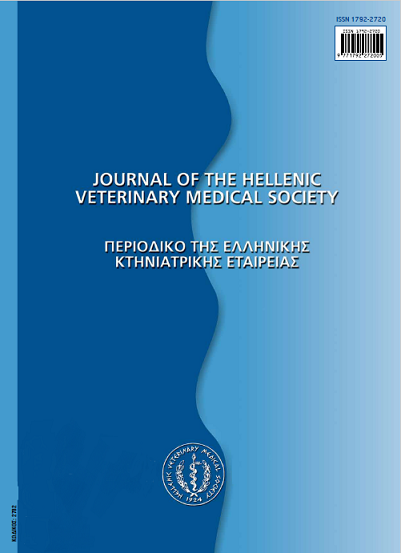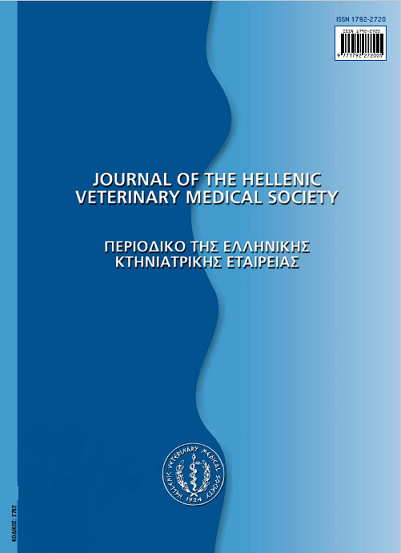Dental problems in rabbits and rodents
Abstract
As the number of pet rabbits and rodents has raised lately, veterinarians have to cope with various medical conditions that affect them and especially those concerning their teeth in everyday practice. Rabbits', guinea pigs and chinchillas whole dentition and the incisors of the rest of the rodents are known as elodont teeth. Malocclusion, which is the most common dental condition seen in those animals occurs due to a combination of several factors and inappropriate diets. The owners frequently fail to recognize their pets' dental disease in time. Consequently, when they are finally presented to the vet, their condition is difficult to be treated and their life is in danger. The examination of the oral cavity should preferably be made under general anaesthesia. Radiological assessment is also essential in order to acquire valuable information about the teeth, roots and facial bones. As mentioned before, malocclusion is the most common dental problem that rabbits and small rodents experience whereas cheekteeth malocclusion is the most frequently recognized problem in guinea pigs and chinchillas. The common factors that contribute are: genetic predisposition (prognathism or brachygnathism), trauma and metabolic disorders. The symptoms vary from difficulty in mastication, bad breath, lesions of the tongue and oral mucosa to facial swelling, abscesses, fistulisation, ocular disease etc. Usually there are also symptoms regarding the animal's general health such as lack of appetite, emaciation and alternation of the feaces' composition. Treatment is both surgical and pharmaceutical. Occlusal equilibration may be accomplished by burring. If this is not possible, the extraction of all the incisors is recommended. In case of an abscess, debridement and extraction of the responsible tooth (usually affecting cheek teeth) is advised. Moreover, antibiotics and analgesics-antinflammatory drugs are of great help. The selection of the appropriate antibiotic should be based on aerobic and anaerobic culture and sensitivity, especially in case of an abscess. The most common antibiotics prescribed are enrofloxacin, Oxytetracycline, doxycycline, amicasin and metronidazole. The most common analgesics are opioids (e.g. fentanyl, buprenorphine, butorphanol) and NSAIDs (e.g. carprofen, meloxicam). Small mamals who are suffering from dental disease have to be treated very cautiously because of their being sensitive by nature. Especially rabbits and guinea pigs are very sensitive to the protracted loss of appetite. The preanaesthetic management is also critical. The complete blood count and serum biochemical analysis, especially in dehydrated and undernourished patients is imperative to be measured, as the iv administration of normal saline or dextrose serum and electrolytes is often needed. There is a positive correlation between feeding the animals on balanced diets (especially in calcium) and avoidance of dental problems. Therefore, prevention could be managed via the combination of appropriate diets and proper advising of the owners. The diet should consist of hay, straws and small quantities of cereals. The veterinarian should inform the owners about proper management of their pet, feeding and periodical examinations that should be done in order to prevent these pathological conditions.
Article Details
- Zitationsvorschlag
-
PAPADIMITRIOU (Σ. ΠΑΠΑΔΗΜΗΤΡΙΟΥ) S., THOMAS (Α. ΘΩΜΑΣ) A., & KOUKI (Μ. ΚΟΥΚΗ) M. (2017). Dental problems in rabbits and rodents. Journal of the Hellenic Veterinary Medical Society, 59(3), 225–238. https://doi.org/10.12681/jhvms.14960
- Ausgabe
- Bd. 59 Nr. 3 (2008)
- Rubrik
- Review Articles
Authors who publish with this journal agree to the following terms:
· Authors retain copyright and grant the journal right of first publication with the work simultaneously licensed under a Creative Commons Attribution Non-Commercial License that allows others to share the work with an acknowledgement of the work's authorship and initial publication in this journal.
· Authors are able to enter into separate, additional contractual arrangements for the non-exclusive distribution of the journal's published version of the work (e.g. post it to an institutional repository or publish it in a book), with an acknowledgement of its initial publication in this journal.
· Authors are permitted and encouraged to post their work online (preferably in institutional repositories or on their website) prior to and during the submission process, as it can lead to productive exchanges, as well as earlier and greater citation of published work.




